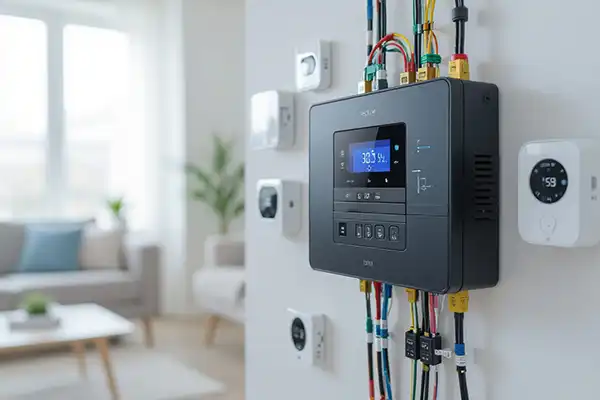
Just adopt a strategic approach to integrating smart systems and IoT into your electrician services. Also, learning device communication standards, securing networks, offering remote monitoring and predictive maintenance. Train your team to install and troubleshoot connected equipment. This ensures your business meets modern client demands, increases recurring revenue through managed services, and positions you as the go-to expert for future-ready electrical solutions. In addition, be sure to research and utilize the best electrical project management software with estimating tools.
Elevating Your Skill Set: Certifications That Matter
The Importance of Nest, Ring, and Lutron Certifications
Google Nest Pro, Ring for Professionals, and Lutron Certified Programmer/HomeWorks tracks combine online modules with hands‑on workshops - typically 2 - 16 hours depending on depth - and unlock dealer status, extended warranty eligibility, priority tech support, and manufacturer tools. Electricians gain access to proprietary installers apps, diagnostic logs, firmware updates, and sometimes API or integration guides that simplify multi‑vendor IoT projects and reduce troubleshooting time on site.
How Certifications Enhance Credibility and Marketability
Having branded certifications and a license lets you appear in manufacturer dealer locators and referral networks, display verified badges on proposals, and satisfy builder or insurance specs that request certified installers for multi‑unit or commercial jobs. Clients and project managers tend to shortlist certified pros first, which increases qualified leads and helps you justify premium pricing on complex smart‑home or commercial IoT installs.
Practical ways to monetize certifications include offering manufacturer‑backed maintenance plans, quoting system integrations (lighting, access control, cameras) with vendor support, and using electrician certification logos in targeted ads or RFP responses. You can cite training hours and specific manufacturer warranties in proposals, demonstrate proficiency with live demos, and win contracts that explicitly require certified installers for advanced features or warranty coverage.
Smart building certifications for the commercial industry is an excellent way to add to your skill level.

The Future of Energy Management: Smart Panels and Load Centers
You can upgrade panels to include integrated CTs, per-circuit metering, smart breakers and Ethernet/Wi‑Fi gateways that enable load scheduling, EV and solar coordination, and tariff-aware load shifting. Manufacturers like Schneider, Eaton and Siemens offer UL‑listed smart panels that stream data at 15‑second to 1‑minute intervals with meter accuracy typically around 1 - 2%, allowing demand response, time‑of‑use savings and predictive maintenance across residential and commercial sites.
Understanding the Role of Smart Panels in Modern Installations
Smart panels replace passive breaker banks with digital control: you can remotely trip or shed specific circuits, monitor per-branch consumption, and set automation rules. Integrated CTs and smart breakers report voltage, current, power factor and energy, enabling you to detect loads drawing anomalous current or identify failing motors via rising inrush. Typical commercial deployments sample data every 15 - 60 seconds to feed analytics and fault detection.
Connecting Load Centers for Seamless Energy Management
Networked load centers communicate with your BMS or cloud via Modbus/TCP, BACnet, MQTT or vendor APIs, letting you orchestrate storage, PV inverters and EV chargers. You can prioritize critical circuits, implement staged load shedding and aggregate feeder data for utility programs. Common practice uses a local gateway to buffer 1‑minute telemetry, translate protocols and enforce TLS-based security between field devices and the cloud.
Design topology matters: run CAT6 or fiber between load centers for high‑bandwidth telemetry, use RS‑485/Modbus for legacy equipment, and clamp split‑core CTs on feeders for non‑invasive monitoring. Stage commissioning with step tests, verify CT accuracy across 10 - 100% load, document settings per NEC labeling, and enable OTA firmware with role-based access. Field pilots that combine per‑circuit control, storage and tariff‑aware scheduling frequently deliver double‑digit peak reductions and faster ROI by cutting demand charges.

Building Strategic Alliances: Collaborating with Industry Partners
Identifying Key Homebuilders and AV Installers
Target production builders that deliver hundreds to thousands of homes annually (national names like Lennar or KB Home often standardize smart packages) alongside regional custom builders who accept higher-margin add-ons; hunt AV partners via CEDIA member lists, local low-voltage/security integrators, and trade shows like NAHB and CEDIA; attend builder association meetings, review recent permit volumes to spot growth corridors, and prioritize partners already specifying smart-home platforms to shorten sales cycles.
Creating Win-Win Partnerships for IoT Solutions
Propose co-branded packages, pilot 10 - 50 home rollouts to prove ROI, and agree on clear revenue-share or referral-fee models; offer training, installation playbooks, and warranty support so builders reduce call-backs while you lock in service contracts; include API access and joint marketing metrics (leads, conversion rates) to measure success and scale the partnership beyond the pilot.
Negotiate contract elements that protect both sides: define SLAs (e.g., install within 48 - 72 hours of closing), data ownership and privacy terms, and a simple RMR split example - if a $20/month subscription yields $240/year, a 50/50 split gives each $120/year per home; set lead-referral fees ($200 - $500) or per-unit prewire discounts for volume (10 - 30% off labor at 100+ homes); require 8 - 16 hours initial training per 100 homes and shared dashboards for KPIs (NPS, churn, install time); a pilot that pre-wired 200 homes reduced per-unit labor by ~25% and produced a 15% attach rate for service plans - use metrics like these to negotiate scale economics.
Designing for Tomorrow: Integrating IoT in Your Services
Electricians should architect systems that support Matter, Zigbee, Z‑Wave and Thread alongside Wi‑Fi 6/6E, providing a clear upgrade path for interoperability. Specify structured Cat6a runs to central hubs, PoE lighting and APs, and plan for VLAN‑segmented IoT networks with 802.1X access and centralized monitoring. Create documentation templates, firmware‑update schedules and three‑tier service packages to make upgrades predictable and profitable for your business.
Assessing Client Needs for Smart Home System Integration
Begin with a 15 - 30 minute questionnaire for your client covering device count (estimate 10 - 50), automation goals, security preferences, and budget. Follow with a 30 - 60 minute site survey using a Wi‑Fi heat‑map, power and load assessment, and wiring inspection. Propose a scope with device lists, required PoE switches, AP placement (typically 1 AP per 1,000 - 1,500 sq ft indoors) and a 12‑month maintenance plan option.
Best Practices for Offering Comprehensive IoT Solutions
Standardize on interoperable platforms (Matter + manufacturer APIs), enforce network segmentation and MFA, provide your team remote management via MQTT/SNMP dashboards, and bundle 12‑month warranties with optional 24/7 monitoring. Offer tiered packages (basic, advanced, premium), clear SLAs (24 - 48 hour response), and client training to reduce misuse and service calls.
In a 2,400 sq ft retrofit you can run four strategically placed APs, a 24‑port PoE switch feeding cameras and APs, and a centralized hub with device inventory and automated firmware policies. Use VLANs and NAC (802.1X) for guests and IoT, document IP assignments and wiring with your as‑built diagrams, and schedule quarterly firmware audits to catch vulnerabilities before they become outages.
Marketing Your Expertise: Promoting Smart Services Effectively
Leveraging Digital Platforms to Showcase Your Skills
Build a portfolio of short project videos and before/after photos on your electrician website and social profiles; video walkthroughs of smart-home installs convert roughly 3x more leads than photo-only galleries. Publish how-to clips on YouTube and TikTok showing device setup, energy-savings calculations, and basic troubleshooting to drive search traffic to your booking page. Use targeted Google Ads and local SEO (optimize for “smart electrician near me”) so your business appears in the local 3‑pack; monitor conversions and tweak bids to improve ROI.
Engaging with the Community to Build a Reputation
Host quarterly workshops or demo nights at community centers or partner hardware stores so homeowners can try smart thermostats, lighting scenes, and security integrations; you can offer a free 20-minute home consultation at the event to convert attendees into clients. Partner with 2 - 3 local builders or realtors to become their recommended smart-systems installer, and encourage satisfied customers to leave Google and Nextdoor reviews—businesses with 50+ reviews see noticeably higher trust and click-through rates.
Run targeted neighborhood campaigns: mailers offering a complimentary energy-audit for the first 10 respondents, booths at farmers markets with live demos, and sponsorship of local tech meetups to raise visibility. Track leads with QR codes and a simple CRM so you can measure which events produce paying clients; one electrician increased smart-install revenue 60% in 12 months after six demo nights plus a $50 referral incentive. Offer short training sessions for property managers to secure recurring maintenance contracts.
To wrap up
On the whole you future-proof your electrician services by embracing smart systems and IoT - upskill in connected-device installation, integrate interoperable platforms, offer remote monitoring and predictive maintenance, and enforce strong cybersecurity and data practices. Standardize scalable solutions, form vendor partnerships, and provide ongoing support and subscription models so your offerings adapt to evolving protocols and client needs, keeping your business competitive and resilient.
